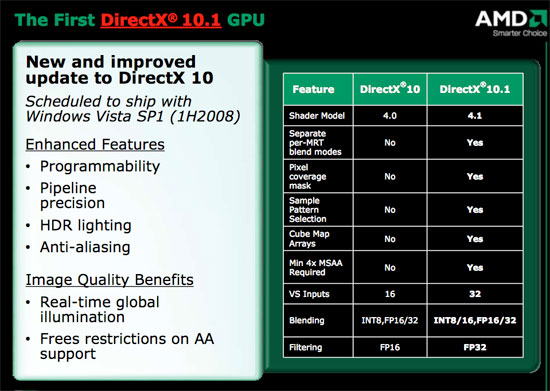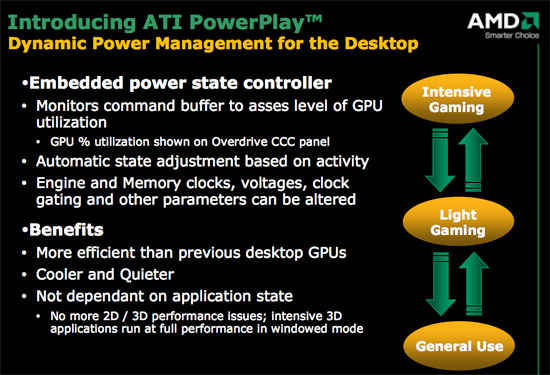ATI Radeon HD 3870 & 3850: A Return to Competition
by Anand Lal Shimpi & Derek Wilson on November 15, 2007 12:00 AM EST- Posted in
- GPUs
New Features you Say? UVD and DirectX 10.1
As we mentioned, new to RV670 are UVD, PowerPlay, and DX10.1 hardware. We've covered UVD quite a bit before now, and we are happy to learn that UVD is now part of AMD's top to bottom product line. To recap, UVD is AMD's video decode engine which supports decode, deinterlacing, and post processing for video playback. The key features of UVD are full decode support for both VC-1 and H.264. MPEG-2 decode is also supported, but the entropy decode step is not performed for MPEG-2 video in hardware. The advantage over NVIDIA hardware is the inclusion of entropy decode support for VC-1 video, but this tends to be overplayed by AMD. VC-1 is lighter weight than H.264, and the entropy decode step for VC-1 doesn't make or break playability even on lower end CPUs.
DirectX 10.1 is basically a release of DirectX that clarifies some functionality and adds a few features. Both AMD and NVIDIA's DX10 hardware support some of the DX10.1 requirements, but since they don't support everything they can't claim DX10.1 as a feature. Because there are no capability bits, game developers can't rely on any of the DX10.1 features to be implemented in DX10 hardware.

It's good to see AMD embracing DX10.1 so quickly, as it will eventually be the way of the world. The new capabilities that DX10.1 enables are enhanced developer control of AA sample patterns and pixel coverage, blend modes can be unique per render target rather, vertex shader inputs are doubled, fp32 filtering is required, and cube map arrays are supported which can help make global illumination algorithms faster. These features might not make it into games very quickly, as we're still waiting for games that really push DX10 as it is now. But AMD is absolutely leading NVIDIA in this area.
Better Power Management
As for PowerPlay, which is usually found in mobile GPUs, AMD has opted to include broader power management support in their desktop GPUs as well. While they aren't to wholly turn off parts of the chip, clock gaiting is used, as well as dynamic adjustment of core and memory clock speed and voltages. The command buffer is monitored to determine when power saving features need to be applied. This means that when applications need the power of the GPU it will run at full speed, but when less is going on (or even when something is CPU limited) we should see power, noise, and heat characteristics improve.

One of the cool side effects of PowerPlay is that clock speeds are no longer determined by application state. On previous hardware, 3d clock speeds were only enabled when a fullscreen 3D application started. This means that GPU computing software (like folding@home) was only run at 2D clock speeds. Since these programs will no doubt fill the command queue, they will get full performance from the GPU now. This also means that games run in a window will perform better which should be good news to MMO players everywhere.
But like we said, dropping 55nm parts less than a year after the first 65nm hardware is a fairly aggressive schedule and one of the major benefits of the 3800 series and an enabler of the kind of performance this hardware is able to deliver. We asked AMD about their experience with the transition from 65nm to 55nm, and their reply was something along the lines of: "we hate to use the word flawless... but we're running on first silicon." Moving this fast even surprised AMD it seems, but it's great when things fall in line. This terrific execution has served to put AMD back on level competition with NVIDIA in terms of release schedule and performance segment. Coming back from the delay in R600 to hit the market in time to compete with 8800 GT is a huge thing and we can't stress it enough. To spoil the surprise a bit, AMD did not outperform 8800 GT, but this schedule puts AMD back in the game. Top performance is secondary at this point to solid execution, great pricing, and high availability. Good price/performance and a higher level of competition with NVIDIA than the R600 delivered will go a long way to reestablish AMD's position in the graphics market.
Keeping in mind that this is an RV GPU, we can expect AMD to have been working on a new R series part in conjunction with this. It remains to be seen what (and if) this part will actually be, but hopefully we can expect something that will put AMD back in the fight for a high end graphics part.
Right now, all that AMD has confirmed is a single slot dual GPU 3800 series part slated for next year, which makes us a little nervous about the prospect of a solid high end single GPU product. But we'll have to wait and see what's in store for us when we get there.










117 Comments
View All Comments
ViRGE - Thursday, November 15, 2007 - link
Testingdustinfrazier - Thursday, November 15, 2007 - link
Going on a year for Nvidia dominance and boy does it feel good. I bought my 8800gtx pair the first day they were available last year and never expected them to dominate this long. God I can't wait to see what comes out next for the enthusiasts. It get the feeling it is gonna rock! I really wanna see what both companies have up their sleeves as I am ready to retire my 8800s.I understand that these latest cards are great for the finances and good energy savers, but what does it matter if they already have a hard time keeping up with current next gen games at reasonable frame rates, 1920x1200 and above? What good does saving money do if all the games you purchase in 08 end up as nothing but a slide show? I guess I just want AMD to release a card that doesn't act like playing Crysis is equivalent to solving the meaning of life. Get on with it. The enthusiasts are ready to buy!
abhaxus - Thursday, November 15, 2007 - link
err, tried to do a hardocp logo and it hid everything in the previous post.text is:
I've read that... but then I've also read on AT and that with current bios releases the asus boards are fine to around 360-400 FSB. I haven't O/C'ed an intel chip since the Celeron 300A so I am pulling my hair out trying to decide if it's worth it to plan for going SLI or just get a P35 board and stay with a single card.
sorry to go so OT. the article was very good in typical anand style.
JonathanYoung - Thursday, November 15, 2007 - link
Just browsing through the article and this graphic caught my eye:Monitors command buffer to *ASSES* level of GPU utilization
Not sure if this is an AMD or AT graphic, but you guys might want to correct it!
Anand Lal Shimpi - Thursday, November 15, 2007 - link
That'd be an AMD graphic, if I had an editable source I'd correct it, but all I've got is the PDF :)Take care,
Anand
imaheadcase - Thursday, November 15, 2007 - link
I have heard quite a few people dislike those line graphs you use, the eyes just don't register lines well vs bars (one reason why long lines are not put in center of roads and they use bars to make the line) Why not stick to bar graphs like you do in the power consumption page?The eyes like things to conform to a shape, or should I say the brain. :) Quick glance at a bar graph is easier for the brain to compute than following lines.
strikeback03 - Thursday, November 15, 2007 - link
Regarding lines on road, this is somewhere on US83 between La Pryor and Leakey in southern Texas.http://img.photobucket.com/albums/v315/strikeback0...">http://img.photobucket.com/albums/v315/strikeback0...
I have no idea what that road marking means.
As for the line charts, I like them better than a multiple bar chart would to display all the same info on a single chart.
Anand Lal Shimpi - Thursday, November 15, 2007 - link
It's always tough finding a good balance, since I can cram so much more information into a line graph than a bar graph. I've just been toying with these things for the 8800 GT and this review, I'll see if I can come up with something better for the next round :)Take care,
Anand
feraltoad - Thursday, November 15, 2007 - link
Can't please everyone I guess. I really like the line graphs. I think it is much easier to compare cards scaling across resolutions and gives a better overview of performance in relation to one another.You could use hand puppets and then everyone would be happy. I know I would :)
JNo - Thursday, November 15, 2007 - link
I second that - lines ftw